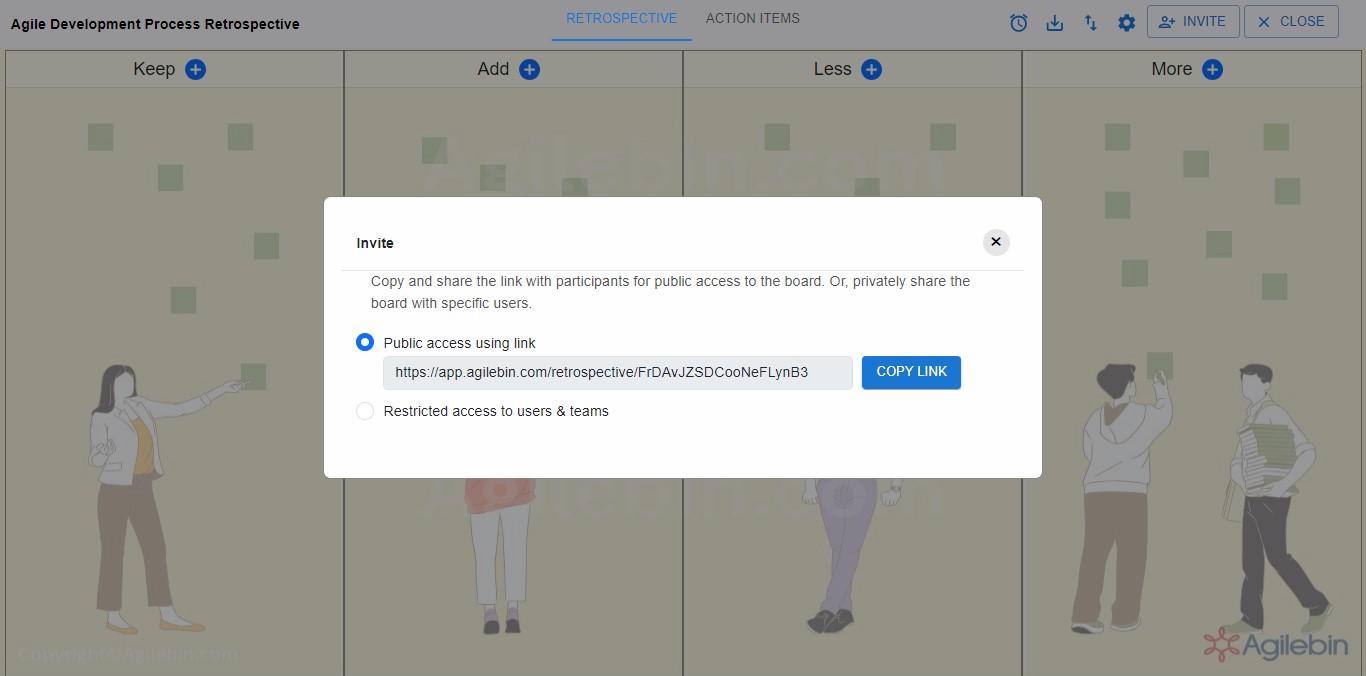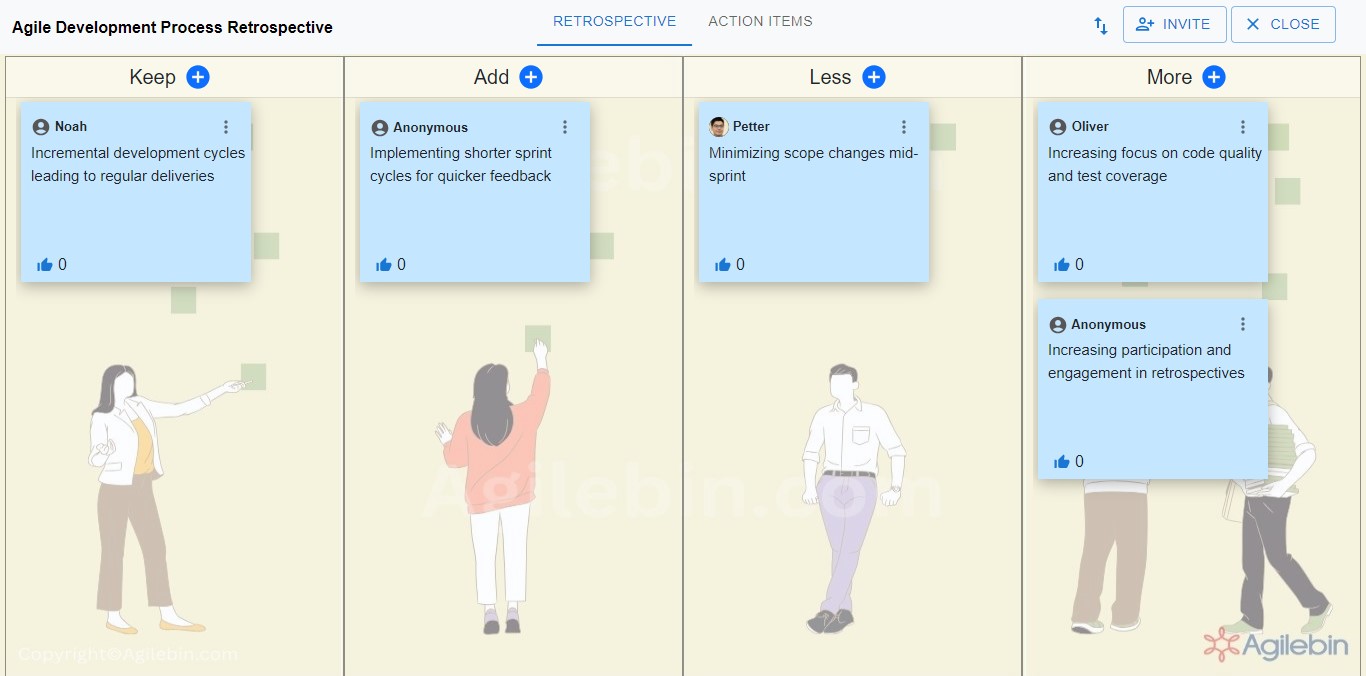KALM Retrospective
Team evaluates what to keep, add, do less of, and do more of for improvement

What is KALM Retrospective?
The KALM retrospective is a structured approach used in agile methodologies for teams to reflect on their recent experiences and plan for improvement. It encourages team members to recognize and discuss successful aspects of their work, brainstorm new practices or tools to enhance their workflow, identify and address less effective elements, and prioritize activities that have been successful for further emphasis. By systematically assessing their performance and committing to concrete actions for improvement, the KALM framework helps teams foster open communication, innovation, and continuous improvement within their projects.
How to Run KALM Retrospective?
Running a KALM retrospective involves several steps to ensure that the team effectively reflects on their recent experiences and plans for improvement. Here's a guide on how to run a KALM retrospective:
- Set the Stage: Begin by explaining the purpose of the retrospective to the team and creating a supportive and open environment where everyone feels comfortable sharing their thoughts and ideas.
- Introduce KALM: Explain the KALM framework to the team, detailing each component (Keep, Add, Lessen, More) and its purpose in the retrospective process. Emphasize that the goal is to collaboratively identify what worked well, what could be improved, and what new ideas or practices could be introduced.
- Gather Input: Provide each team member with sticky notes or index cards and markers. Ask them to individually brainstorm ideas for each component of the KALM framework: what they want to keep, add, lessen, and do more of. Encourage them to be specific and provide examples whenever possible.
- Share and Discuss: Once everyone has written down their ideas, have each team member share one idea for each component. As they share, encourage open discussion and clarification to ensure everyone understands the context behind each point.
- Group Similar Ideas: As ideas are shared, group together any similar suggestions under each component of KALM. This helps to identify common themes and priorities within the team's feedback.
- Reflect and Prioritize: After all ideas have been shared and discussed, take some time as a team to reflect on the insights gained. Discuss which ideas are most significant and prioritize them based on their potential impact on future work.
- Identify Action Items: From the prioritized list of ideas, work together as a team to identify specific action items or improvements that can be implemented in the next iteration or sprint. Assign owners to each action item to ensure accountability.
- Wrap Up: Conclude the retrospective by summarizing the key takeaways and action items. Thank everyone for their participation and remind them that feedback and continuous improvement are essential for the team's success.
- Follow Up: Keep track of the action items identified during the retrospective and follow up on their progress in future meetings. This ensures that the team remains accountable for implementing the identified improvements.
Columns in KALM Retrospective
Typically, the retrospective is divided into four columns:
- Keep: When discussing what to keep, teams reflect on practices, processes, behaviors, or outcomes that have proven successful and contributed positively to their work. This could include effective communication methods, successful collaboration techniques, efficient meeting structures, or any other aspects of their workflow that have consistently yielded positive results. Team members discuss why these elements have been successful and how they have contributed to the team's overall productivity and effectiveness.
- Add: In the "Add" phase, teams brainstorm and discuss ideas for new practices, processes, tools, or behaviors that they believe could enhance their performance or address existing challenges. This could involve introducing new tools or technologies to streamline workflows, implementing new communication strategies to improve collaboration, or adopting new Agile practices to increase efficiency. Team members explore potential opportunities for innovation and improvement, considering both internal team dynamics and external factors that may impact their work.
- Lessen: During the "Lessen" phase, teams identify aspects of their workflow that may be hindering productivity or causing unnecessary complexity. This could include redundant processes, bureaucratic procedures, inefficient meeting structures, or any other elements that are perceived as barriers to success. Team members discuss why these elements may be problematic and explore potential ways to streamline or eliminate them to improve overall efficiency and effectiveness.
- More: The "More" phase focuses on amplifying or increasing the emphasis on practices, processes, behaviors, or outcomes that have been beneficial but may not have received sufficient attention or focus. This could involve dedicating more time and resources to training and skill development, increasing the frequency of certain types of meetings or communications, or reinforcing positive team dynamics and collaboration. Team members discuss the potential impact of doing more of these beneficial activities and commit to taking specific actions to prioritize and enhance them in the future.
When to do a KALM Retrospective
The KALM retrospective is typically conducted at the end of a project iteration or sprint in agile or Scrum methodologies. It's an essential part of the iterative process, providing an opportunity for teams to reflect on their performance, identify areas for improvement, and celebrate successes.
Here are some common scenarios in which teams might choose to conduct a KALM retrospective:
- End of a Sprint: Similar to other retrospective formats in agile methodologies like Scrum, teams can conduct a KALM retrospective at the end of each sprint. This allows the team to reflect on their performance during the sprint, identify what worked well, what could be improved, and what new practices or strategies could be introduced in the next sprint.
- Project Milestones: KALM retrospectives can also be conducted at significant milestones or checkpoints within a project. This could be after completing a major phase of development, reaching a key deliverable, or at the end of a project iteration. It provides an opportunity for the team to reflect on progress, assess outcomes, and adjust strategies as needed.
- Quarterly or Periodic Reviews: Some teams prefer to conduct KALM retrospectives on a regular basis, such as quarterly or bi-monthly. This allows for a more comprehensive review of performance over a longer period, enabling the team to identify trends, patterns, and recurring issues that may require attention.
- After Significant Events or Changes: KALM retrospectives can be valuable after significant events or changes within the team or project, such as the introduction of new team members, changes in project scope, or the adoption of new tools or processes. It provides an opportunity to assess the impact of these changes and make any necessary adjustments.
- As Needed: Finally, KALM retrospectives can be conducted ad-hoc whenever the team feels it's necessary to reflect on their performance, address specific issues, or capitalize on emerging opportunities. This flexible approach allows teams to adapt to changing circumstances and maintain a focus on continuous improvement.
How can you conduct a KALM retrospective with Agilebin?
Effortlessly conduct a KALM retrospective with Agilebin's ready-to-use template!
Why Agilebin's template? Because it provides a realistic and immersive experience, making your KALM retrospective feel authentic and meaningful. With Agilebin's ready-to-use template, you'll feel like you're navigating through the actual process, allowing for a more effective and insightful retrospective session.
Choose KALM retrospective template in Agilebin
Choose the KALM Retrospective template from Agilebin's collection of retrospective templates. This template is specifically designed to facilitate the KALM Retrospective process, providing a structured framework for your team's reflection and improvement discussions
Invite team members to participate in the retrospective session
Invite team members to participate in the retrospective session by adding their email addresses or sharing the session link directly with them. You can choose between public access using a link, allowing anyone with the link to join, or restricted access, limiting participation to specific users or teams.

Facilitate Discussion with Sticky Notes
Agilebin offers pre-defined columns for the KALM Retrospective, including 'Keep', 'Add', 'Less',' More'. Participants can add sticky notes to each column during the retrospective session, sharing their feedback, observations, and suggestions
